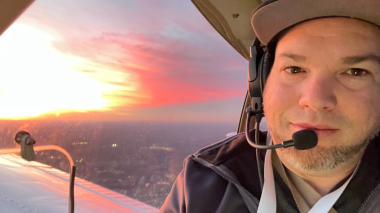Sadie Andrus couldn’t leave the house without a change of clothes. She couldn’t finish a round of golf. She couldn’t spend more than 15 minutes at the gym.
For two years starting in 2019 – at age 49 – such was life, during which Sadie experienced a constant, heavy, menstrual flow. “That was not a great thing,” she says. “I tried a few different things over that time, but nothing changed what I was going through.”
At first, she tried chalking it up to menopause, thinking the condition would go away. But when it persisted for a couple of months and she visited her gynecologist, Kathryn Whitten, MD, at Atrium Health Eastover OB/GYN Arboretum, Sadie learned that menopause doesn’t include periods lasting 45 consecutive days.
An ultrasound revealed fibroids in her uterine wall. They could be shaved, but only partially and with no guarantee of permanent symptom relief. She tried an intrauterine device (IUD), a small T-shaped device that’s inserted into the womb by a doctor or a nurse, for a year, to no avail. Unfortunately, hormonal treatment was ineffective, too.
Sadie eventually was referred to have a traditional hysterectomy, which was scheduled for January 2021. “I said, OK, I’m going to go that route,” she said. “But the more I thought about it and read about it, I was scared,” she says. “I ended up cancelling the surgery.”
Change in plans brings new hope
After cancelling, she waited a couple of months, unsure what to do. Then Dr. Whitten called with a different option that had surfaced recently – Vaginal Natural Orifice Transluminal Endoscopic Surgery (vNOTES) – a new minimally invasive procedure that only Atrium Health offered in the region.
Dr. Whitten told Sadie about how Jerry Matkins, MD, a physician at Atrium Health Eastover OB/GYN, was doing this procedure. Dr. Matkins was an early adopter as doctors gradually incorporated laparoscopy (camera-aided surgery) into traditional hysterectomies about 20 years ago. Now, he’s among the early wave of doctors using the minimally-invasive vNOTES, which was invented in Belgium about five years ago and brought to the United States a few years later.
“I was very interested in vNOTES after seeing a webinar with two of the U.S. doctors who went to Belgium,” Dr. Matkins says. “I’ve always tried to do new things that I think might be beneficial to the patient.”
He says the move toward using laparoscopy for hysterectomies years ago had an unintended consequence: Fewer surgeries are done vaginally, even though such surgeries often result in better and faster recovery for the patient. However, with vNOTES surgery the abdomen is entered through incisions at the top of the vagina. The surgical camera and instruments are then inserted there to complete the procedure. This means that no abdominal incisions are required.
“We got spoiled by seeing everything with the camera and we stopped doing vaginal surgery,” Dr. Matkins says. “I always hoped that we would get back to vaginal surgery, which I wanted to do. After the webinar and speaking with those physicians, I knew vNOTES was the tool we needed to return to vaginal surgery without giving up the visualization. That was my eureka moment.”
Dr. Matkins, who now teaches the procedure to surgeons at Atrium Health and colleagues around the country, began offering it to patients in December 2020.
Successful procedure and improved quality of life
Sadie was intrigued to learn that Dr. Matkins performs non-invasive hysterectomies, vaginally, with no incisions and was referred to him in April 2021.
“I met with him a couple of times and was very impressed with his professionalism,” she says. “He seemed very passionate about his job and what he does. I felt a real connection with that and felt this was going to be a good decision for me.”
She underwent the procedure, which was out-patient surgery that lasted less than one hour. “Recovery was extremely quick and easy,” she says. “It took me only about two or three days before I could get up and walk a normal distance, move my legs and get some exercise.”
After three weeks, Sadie was completing her gym routine at 75% capacity, a month away from lifting or carry anything too intense for her core muscles. Now, she says “my quality of life after surgery, opposed to the two years before, is night and day.”
“I can leave the house with no worries and not have to bring 18 different feminine products. I’m able to exercise and work out, go on vacation and wear a swimsuit,” she says. “I can go to parties, wear white shorts, and spend the evening with friends, with no fear of accidents or needing to leave. It’s absolutely amazing.”
‘Lesser’ conditions count, too
During her two-year menstrual flow, Sadie heard suggestions she might want to “ride it out” until menopause kicked in. She really didn’t want to imagine another two years with her condition.
But she also grappled with thoughts that her circumstances weren’t that bad after all.
“My two-year period was terrible, but other people faced daily challenges from a medical standpoint that are much more severe. I struggled with that. ‘Am I really complaining about a period when so many people are sick with terminal issues and need surgery?’ I had to look back and remember days I couldn’t leave the house.”
Dr. Matkins says 85-90% of the hysterectomies he performs are vNOTES. He hopes that this trend will continue to grow across the industry. Patients should talk to their physician about available approaches if a hysterectomy is needed.
“Not every person is a candidate for every surgery,” Dr. Matkins says. “But it’s important to be armed with knowledge of what’s possible, and to seek out people who can do the least-invasive surgery possible.”
Sadie has a word for women who might be suffering from her former condition.
“If there’s anybody out there like me, thinking its normal at 51 and chalking it up to menopause, you need to know there’s another option,” she says. “If only one woman reads this and gets a glimmer of hope, I’m happy.
This has made me feel like I’m normal, which is nice after being so abnormal for two years.”



